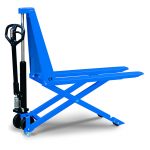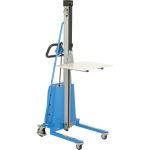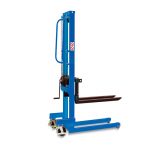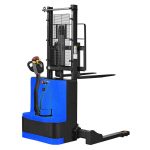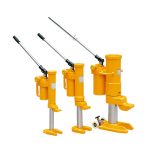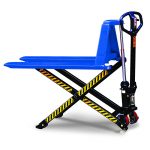Introduction of pallet tilter
LT series lift and tilt pallet jack are designed to lift the pallet and tilt it to the ergonomic angle. LT10M manual pallet tilter & LT10E electric pallet tilter are worked to allow the users to ergonomically reach loads easily without having to bend down or over-stretch. The Electric tilt pallet jack has forced steering on one wheel to make manoeuvring easy. Lift /lower functions are controlled by a switch on the control lever. Tilt/return functions are controlled by a remote control, which is fitted with a long wire, and can make the operator and the tilter with load keep a certain distance, more safer. Lift /lower function and Tilt/return functions can be operated independently of each other or simultaneously. When Tilt/return functions are to be used, the tilter must be on a firm surface, and the universal wheel shall be braked. When Tilt/return functions are to be used to stack materials, the handle can be turned to the side to make access to the stack table easier.
As a pallet tilting equipment, this pallet jack tilter can be used as a pallet truck and also a tilting pallet truck, this can not only improve your work efficiency, but also save costs.
La manija se puede girar y bloquear en posición alejada del área de trabajo. Se aplica tanto a las posiciones sentadas como de pie. Las horquillas del gato de inclinación de la paleta se pueden inclinar hasta 90 grados. Ambos se suministran de serie con freno de estacionamiento y protectores para los pies.
Cumple con EN1757-1 y EN1175
Details of pallet tilter
LT0M manual pallet tilter LT10E electric pallet tilter
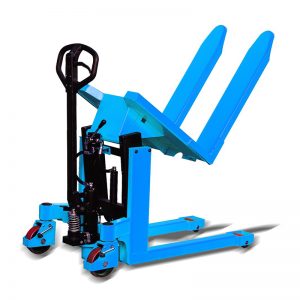
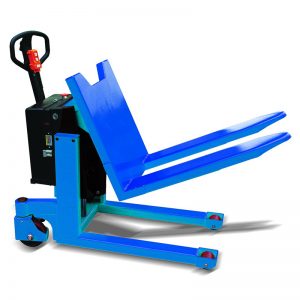
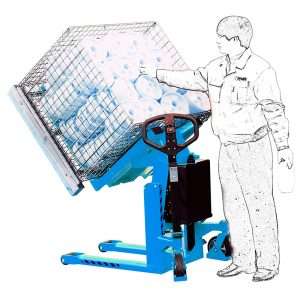
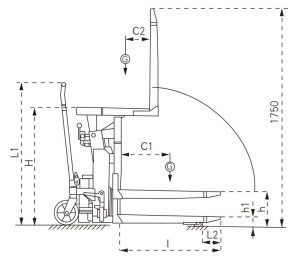
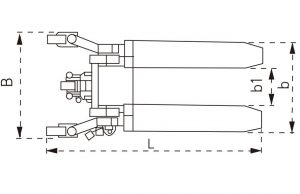
We have this item in stock in France/US, if you are located in Europe or US, we can arrange delivery to you ASAP! This way will save your time and shipping cost.
Specifications of pallet tilter
| i-lift No. | 1520902 | 1520903 | |
| Modelo | LT10M | LT10E | |
| Tipo | Manual | Eléctrico | |
| Capacidad | kg (lb) | 1000(2200) | |
| Altura de elevación vertical | h mm (pulg.) | 285(11.2) | |
| Altura min. De horquilla | h1 mm (pulg.) | 85(3.3) | |
| Longitud de tenedor | I mm (pulg.) | 800(31.5) | |
| Altura del mango | L1 mm (pulg.) | 1138(44.8) | |
| Ancho total de la horquilla | b mm (pulg.) | 560(22) | |
| Ancho entre horquillas | b1 mm (pulg.) | 234(9.2) | |
| Longitud de la punta de la horquilla del rodillo | L2 mm (pulg.) | 135(5.3) | |
| Ancho promedio | B mm (pulg.) | 638(25.1) | |
| Longitud total | L mm (pulg.) | 1325(52.2) | 1410(55.5) |
| Altura total, elevada | H mm (pulg.) | 950(37.4) | |
| Altura total, bajada | H mm (pulg.) | 750(29.5) | |
| Centro de carga Mín. / Máx. | C1 mm (pulg.) | 200/400(8/16) | |
| Centro de carga Mín. / Máx. | C2 mm (pulg.) | 200/420(8/16.5) | |
| Unidad de poder | KW / V | -- | 0.8/12 |
| Peso neto | kg (lb) | 178(391.6) | 185(407) |
Reglas de seguridad
1. Driving the pallet tilter on the slope
1) The pallet tilter shall be unloaded or a small load.
2) La carga debe estar en la posición más baja.
3) The gradient shall be no more than 2° when dragging the pallet tilter.
4) El operador debe estar en la posición superior, ya sea en ascenso o en descenso.
2. Avoid offset loads
La carga debe distribuirse uniformemente en horquillas o paletas, con una distancia de 400 mm entre el centro de gravedad y el frente de las horquillas, la altura máxima del centro de gravedad es de 420 mm, la mínima es de 200 mm, la distancia fuera de este alcance reducirá el nivel de seguridad y aumentar el riesgo.
Las mercancías en paletas o horquillas deben estar debidamente aseguradas, evite el desequilibrio de la carga, de modo que no puedan caerse durante el transporte, cuando se levanta el camión o cuando el camión debe permanecer levantado por un tiempo.
3. Driving loaded
The tilting pallet jack is designed for use on even and level floor. During transport the forks shall be raised as little as possible. Transport with raised forks should be made over the shortest possible distances and at low speed. Do not transport when tilting goods on the pallet tilter, this is not safe.
Advertencia: Nunca coloque las manos o los pies sobre las partes móviles, ya que existe el riesgo de lesiones.


